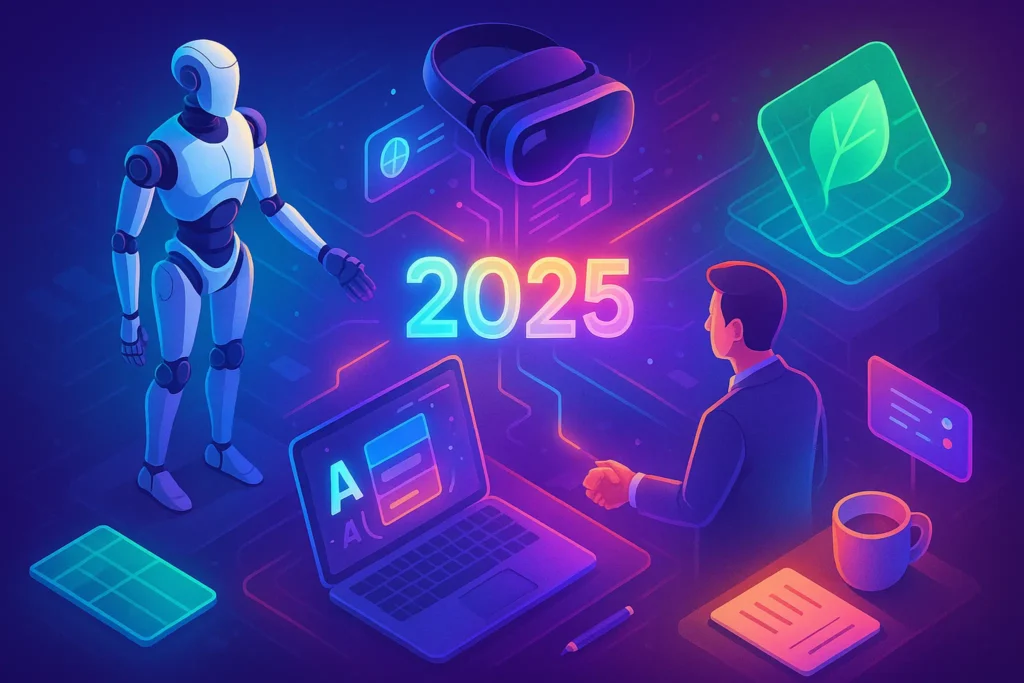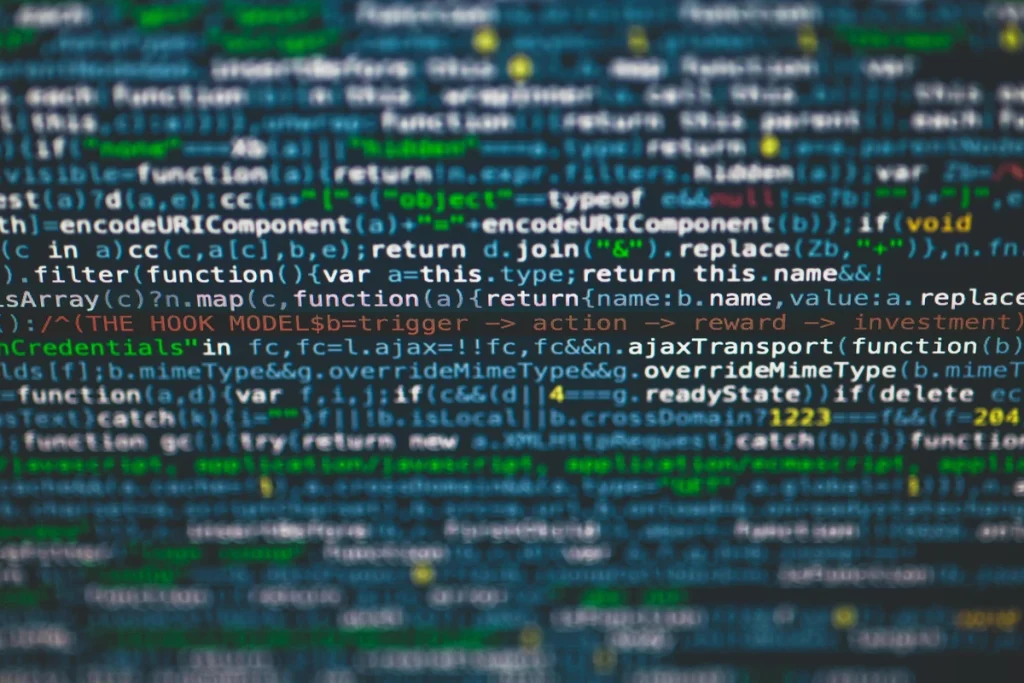-This post may contain affiliate links. If you click on one and make a purchase, I may earn a small commission at no extra cost to you.-
🧭 Introduction
2025 isn’t just another year on the calendar—it’s a threshold. The acceleration of AI, robotics, biotech, and quantum computing is moving us from experimentation to integration. Technologies once confined to R&D labs or sci-fi films are now entering boardrooms, classrooms, operating rooms, and even our pockets. These trends aren’t just “cool”—they’re reshaping how we live, learn, work, and connect.
This post breaks down the 10 most exciting, game-changing tech trends for 2025, offering both the big picture and real-world implications. Some are already rolling out. Others are preparing to transform industries. All are signals of a future that’s no longer 10 years away—it’s already started.
🔍 1. Agentic AI & Multi‑Agent Systems
In 2025, AI evolves from reactive helpers to autonomous decision-makers. Gartner and Capgemini predict a shift to “agentic AI”—smart systems that plan, decide, and act with minimal human input . Imagine booking your travel, drafting a strategy, and executing follow-ups—all coordinated by AI agents working together seamlessly.
Agentic AI represents the next evolution of artificial intelligence—one where systems don’t just respond to prompts but act proactively on your behalf. These AI agents have the ability to understand goals, break them into sub-tasks, and collaborate with other agents to complete them.
In 2025, we’re seeing the rollout of multi-agent frameworks in productivity tools and developer ecosystems. For example, a content creator could instruct an AI assistant to plan a content calendar, write a post, design graphics, and schedule publication—all with minimal human intervention.
What’s driving this? A combination of open-source agentic frameworks (like AutoGen and LangGraph), cloud-integrated LLM orchestration, and real-time tool integration (e.g., Google Workspace, Notion AI). These agents don’t just save time—they unlock compound automation, especially for startups, marketers, and solopreneurs.
🤖 2. AI‑Powered Robotics & Cobots
Robots are no longer just arms in factories—they’re learning, collaborating, and adapting. According to the International Federation of Robotics, AI-driven “cobots” and humanoid systems are expanding across industries . Think of Amazon’s DeepFleet managing warehouse stocks, or Vinod Khosla’s “ChatGPT moment” for home robots that cook and clean.
2025 marks a turning point where robots shift from industrial arms to collaborative teammates. These “cobots” are no longer confined to factories—they’re now in fulfillment centers, hospitals, and even homes. AI allows them to adapt dynamically: they can learn preferences, navigate unpredictable environments, and make decisions with minimal human oversight.
We’re also seeing rising investment in humanoid robots, like Tesla’s Optimus and Figure AI, that aim to support logistics, elderly care, and household tasks. Meanwhile, startups like Miso Robotics are automating food prep and kitchen routines.
Importantly, cobots are not about replacement—they’re about enhancement. The synergy of humans + robots increases safety, reduces physical strain, and boosts operational speed across sectors like manufacturing, healthcare, agriculture, and e-commerce.
🌐 3. Spatial Computing & AR Devices
The era of mixed reality is here. With Apple Vision Pro and rising AR ecosystems, spatial computing is embedding digital layers in our physical world. These interfaces are redefining collaboration, training, and entertainment—from immersive workspaces to AR-enhanced navigation. Posterity builds on trends explored in our Apple Vision Pro Review, showing how immersive tech is fast becoming mainstream.
With the release of Apple Vision Pro and Meta’s upcoming AR hardware, spatial computing is quickly moving from niche to necessity. Spatial computing blends the digital and physical worlds, allowing users to interact with information in 3D space rather than through 2D screens.
In 2025, we expect spatial tech to redefine workflows in architecture, design, education, and remote collaboration. Imagine a surgeon practicing a procedure in a holographic simulation, or a product designer building a prototype in real space before manufacturing.
🛡️ 4. Generative AI for Cybersecurity
Generative models now extend beyond content creation—they’re fortifying defenses. Next-gen cybersecurity systems can detect novel attack patterns, simulate potential breaches, and patch vulnerabilities in real time . While they protect, attackers also leverage AI to evolve threat sophistication, fueling a new arms race in digital defense.
As AI grows, so do threats. But AI is also becoming a powerful defense tool. In 2025, generative AI is being embedded into cybersecurity platforms to detect abnormal behaviors, simulate possible attack vectors, and auto-generate remediation code.
Unlike traditional firewalls that rely on static rules, generative AI can evolve defense systems in real-time. Think of an AI model that writes patches as soon as it detects a novel exploit—or red teams that use AI to simulate zero-day attacks, preparing the system before hackers strike.
This trend also raises questions about an escalating AI vs. AI arms race, explored further in our Big Tech’s AI Arms Race.
🔐 5. Quantum-Proof Cryptography
The specter of quantum computing undermining current encryption is real. As governments prepare quantum-safe standards, organizations are racing to implement post‑quantum cryptographic algorithms—an effort Gartner flags as essential for long-term data integrity. This year, expect pilots encrypting critical networks in finance, healthcare, and defense.
With quantum computing progressing rapidly (as covered in our Quantum Computing series), traditional cryptography may become vulnerable. To counter this, 2025 is seeing the rapid adoption of post-quantum cryptography (PQC)—algorithms designed to withstand attacks from quantum computers.
Agencies like NIST are finalizing new cryptographic standards, and industries like banking and telecom are beginning quantum-proofing of their infrastructures. These aren’t theoretical shifts—they’re urgent security upgrades, especially in light of “store now, decrypt later” threats from nation-states.
🏙️ 6. Digital Twins & Real‑Time Simulation
Digital twins—high‑fidelity virtual replicas of real-world objects—are becoming integral to predictive maintenance and urban planning. From smart factories to city systems, these live models help pre-test decisions, reduce downtime, and improve efficiency across sectors. Innovative firms are now using them to model entire supply chains in real time.
A digital twin is more than just a 3D model—it’s a live, data-driven replica of a physical object, system, or environment. In 2025, industries are using digital twins not just for design—but for real-time optimization.
Cities are building digital twins to model traffic, infrastructure stress, and emergency scenarios. In manufacturing, factories simulate production lines before making physical changes, drastically reducing downtime and cost.
Real estate, energy, and healthcare are next—using twins to model patient care workflows, energy efficiency, and even bio-twin simulations in pharmaceuticals.
🌱 7. Sustainable/Self-Healing Materials
Green innovation is powering new waves. Technologies like structural battery composites, sustainable electronics, and osmotic power systems are moving from labs into real applications. In 2025, expect aircraft skins that store energy, buildings with self-repairing coatings, and concrete that absorbs CO₂—trending disruptively in both tech and climate sectors.
Climate-conscious innovation is no longer a side track—it’s the main road. In 2025, engineers are developing materials that repair themselves, absorb CO₂, or generate energy.
Think:
-
Pavements that regenerate from microcracks
-
Structural battery composites in cars
-
Concrete that absorbs carbon emissions
These materials offer performance and sustainability—disrupting industries from aviation to construction, while making green design a default, not a premium.
🧠 8. Neuro‑Enhancement & Wearables
Wearables go beyond smartwatches. New devices not only monitor health—many will enhance cognition or physical performance. A recent UCLA study explores non‑invasive brain stimulation devices, while AR glasses integrate cognition-assist features. Coming soon: subtle wearable assistants that support focus, memory, and mood widely.
The next frontier for wearables isn’t just physical tracking—it’s cognitive enhancement. In 2025, we’re seeing the rise of non-invasive neural devices that enhance focus, assist memory recall, and even detect mental fatigue in real time.
Startups like Neurosity, Kernel, and Cognixion are leading in this space, building wearables that help users train brain states for peak productivity or emotional regulation. These tools hold potential for education, mental health, and workplace optimization—especially in knowledge economies.
🎥 9. AI‑Generated Media & Deep Synthesis
Generative content is stepping into video, audio, and 3D. Google’s Veo 3 can produce AI-generated video with synchronized audio, and DeepMind’s AlphaEvolve writes code and optimizes algorithms dynamically. Even personalized AI avatars and interactive media are becoming viable—redefining entertainment, education, and marketing narratives.
Generative AI is reshaping media production. From deepfake actors in marketing campaigns to real-time 3D rendering of virtual worlds, AI-generated media is becoming a mainstream creative force.
What started with ChatGPT and Midjourney is now evolving into video, sound, and avatar ecosystems. In 2025, AI-powered platforms can auto-generate explainer videos, training material, and even 3D walkthroughs for product demos.
We’ll also see interactive AI companions in games, education, and customer service—moving us closer to immersive, responsive content at scale.
🔋 10. Edge AI & Neuromorphic Hardware
AI is moving out of the cloud and into devices. Efficient chips inspired by the human brain—neuromorphic hardware—are enabling ultra-low latency AI in sensors, cameras, wearables, and vehicles. Expect on-device speech recognition and pattern detection with minimal power consumption, crucial for smart cities, remote healthcare, and autonomous systems.
The cloud is powerful—but not always fast or private enough. Edge AI brings intelligence directly into devices, using low-power, brain-inspired processors that can make decisions without internet access.
From autonomous drones to smart traffic lights and remote medical diagnostics, neuromorphic chips allow real-time responsiveness without draining battery life. They mimic neurons and synapses to handle vision, sound, and motion data efficiently.
This trend makes AI smarter and greener—two goals increasingly inseparable in 2025.
🌐 Macro Trends & Industry Forces
These ten trends unfold under a larger narrative. Tech giants—like Google and OpenAI—racing for control of AI platforms will determine who shapes these futures. The same AI arms race propelling global innovation also accelerates these emerging trends .
Bonus
And while many of these trends may sound like distant promises, some are already tangible. From spatial computing headsets and AI‑powered personal assistants to robots that help with cooking or cleaning, we’re witnessing a moment where futuristic tech is no longer just speculative—it’s available. If you’re curious about what you can actually get your hands on today, check out our deep dive on Futuristic Gadgets You Can Own Now. It’s a reality check (in the best way) on how science fiction is becoming science fact.
🧠 Nerd Verdict
2025 isn’t just advancing existing technologies—it’s converging multiple frontiers. AI, robotics, quantum, and sustainability are merging into a highly interconnected landscape. The opportunities are vast, but so are the challenges: ethics, regulation, and inequality must also evolve. Your best play: understand how these technologies shape each other and prepare to integrate them strategically.
❓ FAQ
Q: Which trend delivers consumer impact first?
A: Augmented reality and cobots in retail, smart homes, and healthcare—expect them to hit mainstream this year.
Q: Should businesses invest now or wait?
A: Pilot projects in cloud platforms (Azure Quantum, AWS Braket) and wearable platforms are ready now—delay risks being unprepared.
Q: Are these all speculative?
A: No—many are in active deployment or prototyping. Digital twins, generative cybersecurity, and neuromorphic edge are already working in enterprise environments.
💬 Would You Bite?
What trend on this list feels game-changing—and which feels too sci-fi? Want a deep-dive guide on AR, robotics, or sustainable materials? Or ready to pilot these ideas in your team?
Drop a comment—I’ll craft strategy frameworks or demo workflows tailored to your interests.👇



